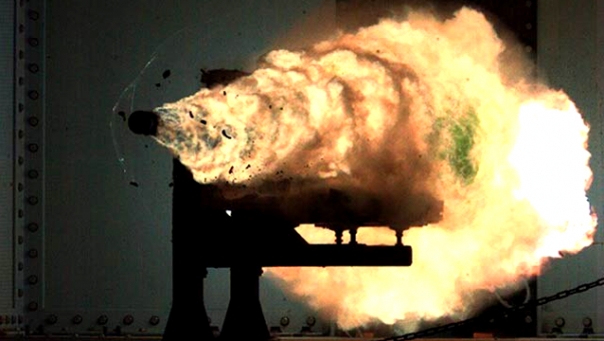
A theoretical dream for decades, the railgun is unlike any other weapon used in warfare. And it’s quite real too, as the U.S. Navy has proven in a record-setting test today in Dahlgren, VA.
Rather than relying on a explosion to fire a projectile, the technology uses an electomagnetic current to accelerate a non-explosive bullet at several times the speed of sound. The conductive projectile zips along a set of electrically charged parallel rails and out of the barrel at speeds up to Mach 7.
The result: a weapon that can hit a target 100 miles or more away within minutes.















#23. The more I thought on the matter, a better response occurred to me. Because of the vast difference in mass you can simply ignore conservation of momentumin in this context unless you are extremely OCD.
#27 – You might want to go back and study some high school physics.
Make them bigger so the projectile could reach orbit and we could hit anywhere. Couple that with a nuclear pkg. in the projectile and you’d really have something.
As for why, anyone who would try to lower the American standard of living needs to be exterminated for the good of mankind.
Reaction effects in baseball throwing. Three step experiment:
Step 1 – Throw baseball as hard as you can.
Step 2 – Repeat Step 1 exactly, but without baseball.
Step 3 – Consider medical attention.
The difference is the reaction effect.
#18 & #33: Not LEO, but reminds me of Robert Heinlein’s “The Moon is a Harsh Mistress” (1966).
A moon colony revolt. A huge Electromagnetic gun, built for sending supplies to earth, needs a mere 5300 mph for the moon’s escape velocity & no air interference. Earth’s gravity adds another 20,000 mph.
Turned into a weapon by the revolutionaries. Loaded with huge rocks in a projectile configuration rather than recovery, near atomic weapon strength (according to the book).
I’m doing this on a napkin, so be kind. The numbers are round and not accurate for the test. Please pardon me if my “metric” is off. I’ve used english units since exiting college and working on 20 years of memory for Newtons.
Force involved depends on the acceleration. If they are accelerating a small warhead (say 100 kg) to a speed of Mach 7 (~2 km/sec I believe) in 0.1 seconds, they need to be employing an acceleration of 20 km/sec^2 (v=at). Total kinetic energy would be F=ma=2M Newtons.
That is a lot of energy that has to be absorbed by the gun, but looking at the gun I’d say it’s easily 2000 kg, plus if it has 1,000 anchor bolts capable of each taking 2,000 Newtons (not that big a deal) of force into an enormous foundation, it doesn’t move much at all.
The gun in my example is 200m long (from x=at^2). I assume the gun is probably more like 50m long which would vastly increase the actual force on the gun.
I don’t get the point. This thing is not portable. Meh, a proof of concept.
# 35 springfield_tom – Thank you. That is, indeed, the novel I was remembering.
This product isn’t ready to stick in a ship or or in a tank yet.
I think they are also working on getting a version with some degree of guidance but missiles can do the ground hugging/radical direction change bit and normally artillery can pull the from behind the hill bit using guided ammo.
This thing may be able to do over the horizon but you are going to have to stick with a relatively flat trajectory because if it slows down to much it’s pretty much stops being a wonder weapon.
These things are for use in space ’cause them aliens dun’ worship Jesus.
Tom Swift and his Electric Rifle ! How fast can it fire in Rounds per Minute or Rounds per Hour ? Charging up to the 33 MegaJoules must take some time…
This was a 1/2 power test, at full power, the range goes to 250 miles.
I suspect hypervelocity projectiles will take out anti-ship missiles, ballistic or flying.
Every 5 seconds, just one of these gizmos will get a projectile out 2 miles in the first second, even a maneuvering target might find it very hard to get out of the way.
Blessed are those who keep their head down.
I wonder how they keep the rails from vaporizing or at least pitting or melting after firing a few rounds? The projectiles + enormous current are extremely rough on any metal that comes to mind…
The next gen aircraft carriers are already testing this for launching aircraft (at a much slower velocity of course), rather than the traditional steam catapult systems.
“Another advantage? NO EXPLOSIVE CARTRIDGES. Bullets and missiles ARE explosive, TOTALLY if handled improperly…NOW all you need is the bullet, which ISNT explosive.”
With any sort of weapon, you’re always concerned it may harm you instead of the enemy by discharging its energy locally instead of far away. The rail gun doesn’t have explosives to harm you, but it does have that electrical system of amazing capacity right in your lap on a ship. If the enemy can set that off to discharge all its energy potential at ones, it would be *just like*, say, the munitions in a magazine blowing up at once. A smart enemy would send one aircraft(a “railgun buster”)forward to short-circuit the power supply and just melt that ship into the sea.
In warfare, there is no magic bullet or free lunch!